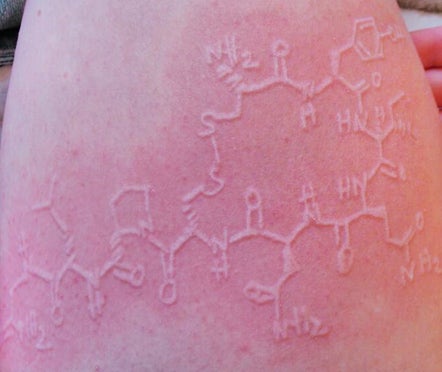Dermatographia urticaria: Teaching science by drawing molecules on skin
The condition means you can draw on almost any part of the body as the skin overreacts to touch. The effect lasts half an hour, after which it returns to normal. What better way to grab students' attention?

Your support helps us to tell the story
From reproductive rights to climate change to Big Tech, The Independent is on the ground when the story is developing. Whether it's investigating the financials of Elon Musk's pro-Trump PAC or producing our latest documentary, 'The A Word', which shines a light on the American women fighting for reproductive rights, we know how important it is to parse out the facts from the messaging.
At such a critical moment in US history, we need reporters on the ground. Your donation allows us to keep sending journalists to speak to both sides of the story.
The Independent is trusted by Americans across the entire political spectrum. And unlike many other quality news outlets, we choose not to lock Americans out of our reporting and analysis with paywalls. We believe quality journalism should be available to everyone, paid for by those who can afford it.
Your support makes all the difference.When I’m not researching how molecules can alter the shape of DNA, I use my skin to draw drug molecules. I’m a lecturer in Chemical Biology in the School of Pharmacy at UEA, and every day I post a new molecule on my Twitter feed (@InnocentWal). But what’s the point?
I suffer from a skin condition called dermatographia urticaria which means my body overreacts to touch. I can draw on almost any part of my body and after a few minutes, it becomes raised as a white bump on the flushed skin. The effect lasts for about half an hour, after which my skin returns to normal.
Initially I was (in more ways than one) irritated. Working with chemicals in particular led to colleagues thinking I’d burnt myself with something, but it was just my skin reacting to a simple scratch or bump. When I was in the process of finding out what this condition was, a colleague of mine directed me towards Ariana Page Russell a USA-based artist who uses her skin for her artwork. I was impressed at the intricate level of detail she was able to achieve, simply by irritating her skin. This, coupled with my love of chemistry, inspired me to draw molecules on my body.

Teaching and learning in higher education is changing. In the distant past, university teaching involved providing lectures and demonstrations about a subject where students would take notes. It has long been well accepted that lectures are a poor method of teaching; the average retention rate of material 24 hours after a lecture is only 5%.
So when I started as a lecturer in 2010, I came to question: what purpose does the simple delivery of content have in higher education? Modern lifestyles are crammed with technology: 24-hour access to apps, internet resources and social media. As part of studying towards a MA in Higher Education Practice, I began to explore using different methods to teach. Everyone learns in a different manner, so including multiple opportunities to learn in different ways appeals to a wide audience.
I’m lucky to be part of a forward-thinking school and our success in Pharmacy at UEA has been created through a foundation of using different teaching methods, such as traditional lectures, team/problem based learning, tutorials, workshops and laboratory classes. Encouraged by Professor Simon Lancaster in the School of Chemistry, I learnt about how he used different technologies in his teaching such as lecture capture, audience response systems and Twitter.
The impact on my teaching has been significant: I now record all of my lectures, so the students can re-play them back at any time, or so I can use the recording for next year if I choose to “flip” the lecture. I am getting to grips with using audience response technologies, to assess learning and understanding of a whole cohort of students in real-time. Finally, I now use of Twitter in learning and teaching: it’s a round the clock opportunity to engage with people from around the world. Some use it within their lectures to poll opinions, I decided to use it as an additional resource, to supplement teaching and engage with a wider audience, as a reminder of what different drugs do or are used for.
We encourage our students to have a working knowledge about the top 100 drugs they are likely to encounter most regularly as a Pharmacist in the UK. Developed by Professor David Wright, we have a Pharmacy based version of “Top Trumps”. I use these examples of drugs throughout my teaching as it automatically ties in with what they are learning in the other areas of the course. I am passionate about how compounds and drug molecules interact with the human body; the structures of these molecules, their shape and elemental composition, has always fascinated me, so this is something I knew I wanted to develop further.
My #moleculeoftheday and #drugoftheday tweets are something extra, another dimension to what I do every day. It’s a fun way to show people what drugs look like. Yes, it is an awful lot easier to write on a blackboard, but to capture someone’s attention, this certainly is more effective.
Join our commenting forum
Join thought-provoking conversations, follow other Independent readers and see their replies
Comments